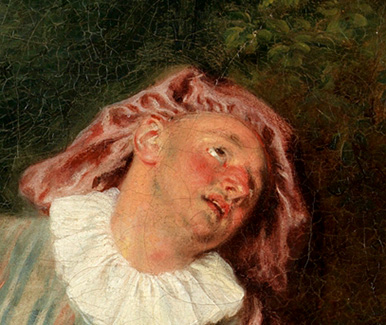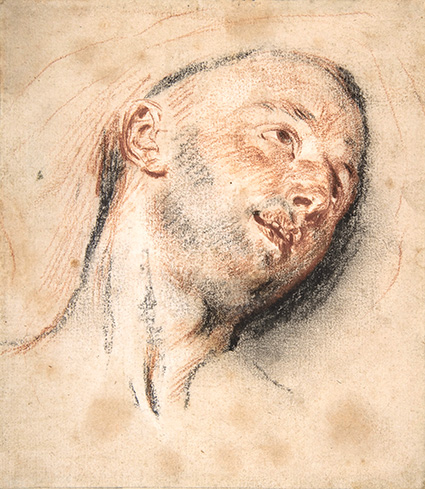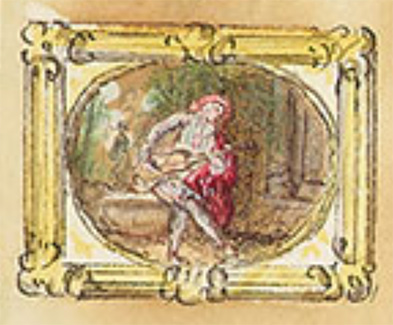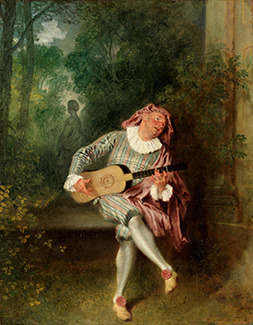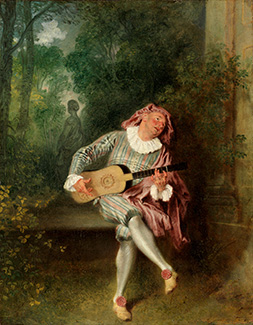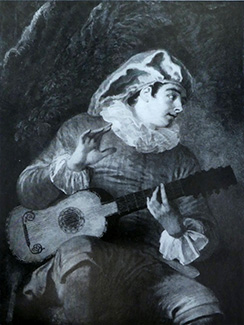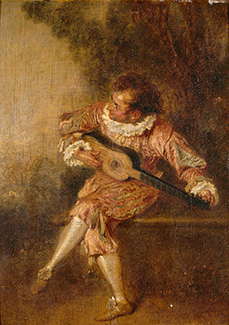
- Home Page
- Accepted
Paintings & Copies - Doubtful
Attributions - Doubtful Textual References
- Alternative
Titles - Collectors &
Museums - Bibliography
- Search Abecedario
- Watteau &
His Circle
Mezetin
Entered July 2025
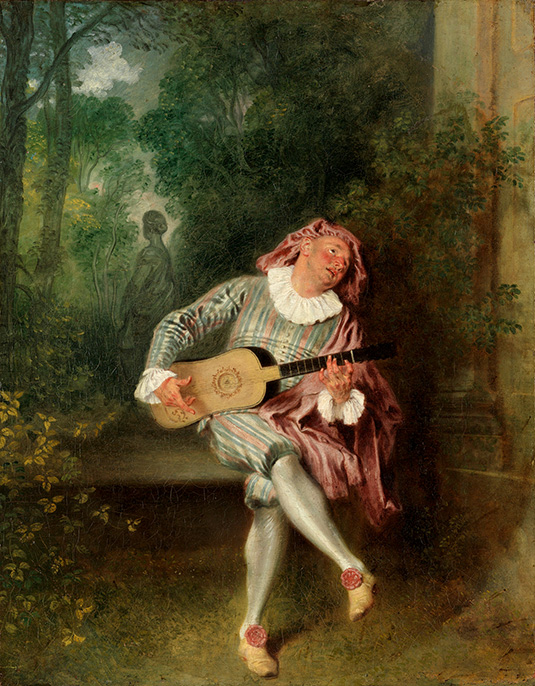
New York, Metropolitan Museum of Art, inv. 14.138
Oil on canvas
55.3 x 43.1 cm
ALTERNATIVE TITLES
Joueur de guitarre
Mesetin
Mezzetin
Mezzetin die Guitarre spielend
Un Mézétin jouant de la guitare
RELATED PRINTS
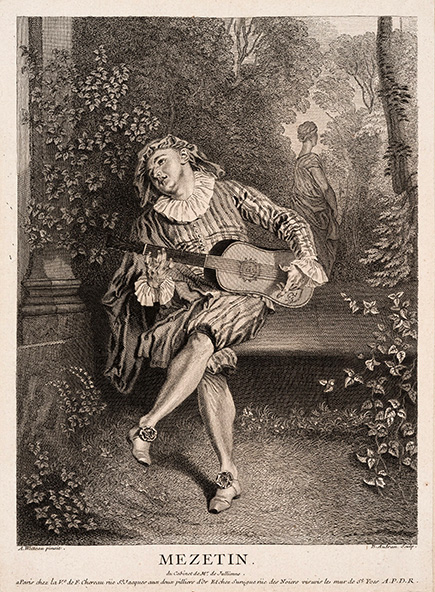
Bernard Audran after Watteau, Mezetin, engraving, prior to 1735.
The painting was engraved before 1735, in reverse, by Bernard Audran. It may well be that Audran amplified the brees and foliage in the four corners of the composition to overcome the slight paucity of details there.
It should be noted that as engraved, the title of the painting appears as "Mezetin" with a single "z" and without an artcle such as "Le."
PROVENANCE
Paris, collection of Jean de Jullienne (1686-1766; director of a tapestry factory). The caption on the Bernard Audran print states: “du Cabinet de Mr de Jullienne.” The painting is listed and illustrated—but with serious errors—in the c. 1756 manuscript catalogue of Jullienne’s collection, now in the Morgan Library and Museum, New York. His sale, Paris, March 30–May 22, 1767, lot 253: “Un Mézétin jouant de la guitarre, il est assis sur un banc dans un Jardin. Ce Tableau est bien conservé, les carnations ont le coloris de Rubens: ces avantages le distinguent. Il est peint sur toile, de 20 pouces de haut, sur 17 de larg. Sa forme est ovale." Although the dealer Pierre Remy is the recorded buyer, according to Somof, Mezzetin was bought for 708 livres on behalf of Catherine the Great. In an annotated version of the catalogue, Pierre Jean Mariette wrote : “Ce n'est pas dans ce tableau que Wateau brille. Il y a trop de maniere”.
St. Petersburg, collection of Catherine II (1729-1796; Empress of Russia); cited in the 1786 Catalogue of Paintings of the Marble Palace.Sold by the Russian government to Calouste Gulbenkian in 1930.
London, collection of Calouste Gulbenkian (1869-1955; petroleum industrialist). Sold to Wildenstein & Company on June 27, 1930, according to the Wildenstein stock book.
Paris and New York, with Wildenstein & Company, 1930-1934.
Bought by the Metropolitan Museum of Art on November 21,1934, according to the Wildenstein stock book.
EXHIBITIONS
Chicago, Art Institute, Century of Progress (1934), cat, 154 (as by Watteau, Le Mezzetin, [Angelo Constantini, the Actor], lent by Wildenstein).
Copenhagen, Charlottenborg, L’Art français au XVIIIe siècle (1935), cat. 260 (as by Wateau, Le Mezzetin, lent by the Metropolitan Museum of Art).
New York, Metropolitan Museum, French Painting and Sculpture (1935), cat. 5, p. 105ff (as by Watteau, Le Mezzetin, lent by the Metropolitan Museum of Art).
Paris, Palais national, Chefs-d’oeuvre (1937), cat. 231 (as by Watteau, Le Mezzetin, lent by the Metropolitan Museum of Art).
New York, Wildenstein, Masterpieces (1951), unnumbered (as by Watteau, The Mezzetin, lent by the Metropolitan Museum of Art).
New York, Metropolitan Museum, Art Treasures of the Metropolitan (1952), cat. 127.
New York, Metropolitan Museum, Masterpieces of Fifty Centuries (1970), cat. 303 (as by Watteau, Mezzetin lent by the Metropolitan Museum of Art.
Toledo, Chicago, Ottawa, Age of Louis XV (1975-76), cat. 121 (as by Watteau, Mezzetin [Mezetin], lent by the Metropolitan Museum).
New York, Wildenstein, Paris—New York (1977), cat. 54 (as by Watteau, Mezzetin, lent by the Metropolitan Museum).
Washington, Paris, and Berlin, Watteau, (1984), cat. P49 (as by Watteau, Mezzetin [Mezetin] (lent by the Metropolitan Museum of Art).
Ottawa, National Gallery, Age of Watteau, Chardin, and Fragonard (2003), cat. 10 (as by Watteau, Mezzetin, lent by the Metropolitan Museum).
New York, Wildenstein, Arts of France (2005), 53, 72, cat. 24 (as by Watteau, Mezzetin, lent by the Metropolitan Museum).
New York, Metropolitan Museum, Watteau, Music and Theater (2009), cat. 12 (as by Watteau, Mezzetin [Mezetin] lent by the Metropolitan Museum), 13, 82, 84.
Brussels, Palais des beaux-arts, Watteau, Leçon de musique (2013), under cat. 122 and (as by Watteau, Mezzetin, lent by the Metropolitan Museum of Art).
SELECT BIBLIOGRAPHY
St. Petersburg, Hermitage, Catalogue (1774), no. 402.
Hédouin, “Watteau” (1845), cat. 43.
Hédouin, Mosaïque (1856), cat. 43.
Goncourt, L’Art au XVIIIème siècle (1860), 57.
Horsin-Déon, “Notices sur les cabinets d'amateurs” (1861), 247.
Waagen, Die Gemäldesammlungen (1864), 3: no. 1503, 304-05.
St. Petersburg, Hermitage, Catalogue (1869-71), III: 53.
Goncourt, Catalogue raisonné (1875), cat. 86.
Dohme, “Die Französische Schule des XVIII. Jahrhunderts” (1883), 241 note 1.
Mollet, Watteau (1883) cat. 86.,
Hannover, Watteau (1888), cat 94.
Dargenty, Watteau (1891), 68.
Phillips, Watteau (1895), 72.
Dilke, French Painters (1899), 82.
Staley, Watteau (1902), 68-69, 143.
Somov, Catalogue de la galerie des tableaux (1903), 3: cat. 1503.
Fourcaud, “Scènes et figures théatrales” (1904), 137, 139.
Josz, Watteau (1904), 222, pl. opp. 110.
Foster, Watteau to Prud’hon (1905), pl. 29, 100.
Wrangell, Les Chefs-d’œuvre (1909), xxxii.
Zimmermann, Watteau (1912), 187, pl. 41.
Pilon, Watteau et son école (1912), 95.
Benua, Kartinnoi Galereye Imperatorskago Ermitazha (1911).
Dacier, “Les Premiers amateurs de Watteau” (1921), 118.
Dacier, Vuaflart, and Hérold, Jean de Jullienne et les graveurs (1921-29), 2: 58, 67, 93, 97,102, 132, 151; 3: cat. 215.
Hildebrandt, Antoine Watteau (1922), 28.
Réau, Histoire de la peinture française (1925), 1: 18.
Réau, “Watteau” (1928), cat. 57.
Réau, L’Art français dans les musées russes (1929), cat. 414.
Réau and Loukomski, Catherine La Grande (1930), 84.
Wilenski, French Painting (1931), 108.
Dacier, "Vente Coypel" (1932), 2: 131.
Wehle, "Le Mezzetin” (1935), 12-18.
Allen, “Drawings from the Biron Collection” (1938), 77.
Parker, Drawings in the Ashmolean (1938), 1: cat. 560.
Barker, Watteau (1939), 137.
Williams, “Some French Drawings” (1939), 51.
Thieme and Becker, Allgemeines Lexikon (1907-1950), 35: 193.
Benisovich, "The French Drawings of the Metropolitan Museum" (1943), 70.
New York, Metropolitan Museum, European Drawings (1943), 2: cat. 31.
Brinckmann, Watteau (1943), 29, fig. 62.
Courville, Un apôtre de l'art (1945), 191–200.
Tietez, Master Drawings in the United States (1947), 166 under cat. 83.
Davenport, Book of Costume (1948), 2: 664
Shoolman and Slatkin, Six Centuries (1950), under cat. 25.
Adhémar, Watteau (1950), 99-101, 119, cat. 206.
Huyghe, "Vers une psychologie de l'art" (1951), 134–35, 138–39, 141.
Allen and Gardner, A Concise Catalogue (1954), 102.
Rousseau, “Guide to the Picture Galleries” (1954), 5.
Lévy, “Watteau's 'Le Lorgneur,'” (1954), 198.
Sterling, French Paintings (1955), 1: 105-08.
Mathey “Une Feuille d’études” (1956), 215.
Adhémar, “Watteau et ses amis” (1956), 20.
Parker and Mathey, Watteau, son oeuvre dessiné (1957), cat. 96, 726.
Chastel, “Peintures françaises en Russie” (1958), 41-2.
Sterling, Great French Paintings (1958), 231 n. 12.
Mathey, “L’importance capitale” (1959), 43.
Mathey, Peintures réapparues (1959), 36, 55, 68.
Descargues, Le Musée de l’Hermitage (1961), 32.
Mirimonde, “Sujets musicaux chez Watteau” (1961), 253, 261.
Schefer, “Visible et thématique” (1962), 51.
Mirimonde, “Les instruments de musique” (1963), 49.
Eidelberg, Watteau’s Drawings (1965), i-ii, 22-24.
Cailleux, “A Rediscovered Painting” (1962), iii.
Nicoll, World of Harlequin (1963), 78-79.
Bean, 100 European Drawings (1964), cat. 56.
Eisler, “Two Immortalized Landscapes” (1966), 165.
Levey, Rococo to Revolution (1966), 72, 78.
Schneider, The World of Watteau (1967), 104-05.
Brookner, Watteau (1967), 37.
Macchia and Montagni, L’opera completa di Watteau (1968), cat. 193.
Perdigão. Calouste Gulbenkian (1969), 109–10, 113, 229.
New York, Metropolitan Museum of Art. Masterpieces of Painting (1970), 66
Charmet, French Paintings (1970)
Held and Posner, 17th and 18th Century Art (1971), 303.
Ferré, Watteau (1972), 1, under 1753 and 1877; 2: 461, 659; 3: 811-812, 898–901, cat. A 37; 4: 1099, 1103.
Ferré, “Watteau, metteur en scène de génie” (1973-74), 56.
Butler, “The Age of Louis XV” (1975).
Paris, Musée de la monnaie, Pèlerinage (1977), 1: 101, 106-09.
Boerlin-Brodbeck, Watteau und das Theater (1973), 170, 173–76, 231, 256 n. 49.
Zolotov, Watteau (1973), 14, 25.
Paulson, Emblem and Expression (1975), 95–97.
Salinger. "The Price Was Not Too High," (1975), 198–200.
Hayes, Gainsborough (1975), 201.
Banks, Watteau and the North (1977), 121, 183–84.
Mirimonde, L'Iconographie musicale sous les rois Bourbons (1977), 2: 34–35.
Williams, Russian Art and American Money (1980), 149, 160–61, 180, 182.
Guerman, Antoine Watteau (1980), cat. 235.
Roland Michel, Watteau (1984), 52, 204, 230, 266, 269, 273, 279, 298.
Posner, Watteau (1984), 57, 206-8, 258, 288 n. 16.
Borowitz, “Three Guitars” (1984), 116-29.
Sutton, "Antoine Watteau” (1985), 156.
Zolotov, Antoine Watteau (1986), 10, 13.
Bean, 15th–18th Century French Drawings (1986), 297.
Lefrançois, “L’Influence de Watteau sur Coypel” (1987), 65.
Moutsopoulos,"Les structures de la temporalité" (1987), 147.
Eidelberg, "Watteau in the Atelier of Gillot" (1987), 55.
Boerlin-Brodbeck, "La Figure assise dans un paysage" (1987), 167.
Gétreau, “Watteau et la musique” (1987), 241.
Rorschach, “French Art and the Eighteenth-Century Garden” (1990), 111-12.
Luciano, The Mask of Comedy (1990), 5.
Moureau, De Gherardi à Watteau (1992), 95, 123.
Jollet, Watteau (1994), 54–56.
Garnier-Pelle, Chantilly, Musée Condé, peintures (1995), 134, 152–53.
Baetjer, European Paintings (1995), 368.
Rosenberg and Prat, Watteau, Catalogue raisonné des dessins (1996), cat. 464, R 488.
Börsch-Supan, Antoine Watteau (2000), 124–25.
Plax, Watteau and Cultural Politics (2000), 131, 135, 138–39.
Whiteley, Drawings in the Ashmolean (2000), under cat. 833.
Temperini, Watteau (2002), 119, cat. 102.
Grasselli, Review of Whiteley, Drawings in the Ashmolean (2003), 67.
Berlin, Alte Nationalgalerie Berlin, Goya: Prophet der Moderne (2005), 66, 348.
Plax, "Belonging to the In Crowd” (2007), 53–54, 64–65.
Bailey, “Genre Painting in Eighteenth-Century France” (2008), 342.
Tillerot, Jean de Jullienne et les collectionneurs (2010), 136, cat. 210.
Vogtherr and Tonkovich, Jean de Jullienne (2011), 143.
Glorieux, Watteau (2011), 294.
Tillerot, “Engraving Watteau” (2011), note 17.
Moureau, Le goût italien (2011), 101.
Ziskin, Sheltering Art (2012), 200, note 123.
Delon, The Libertine: The Art of Love (2013), 146.
Wile, Watteau (2014), 330.
Galitz, Masterpiece Paintings (2016), 283, 297, no. 275.
Sund, “Why So Sad?” (2016), 326.
Brussels, Palais des beaux-arts, Watteau, Leçon de musique (2013), under cat. 47, 122, 123.
Hinton, “Fiske Kimball and French Period Rooms” (2017), 61, 297.
Gammon, Deaccessioning and Its Discontents (2018), 286.
Androsov, Western European Painting (2018), 26.
Jeffares, “Minutiae at the Met” (2019).
Jeffares, Review of Baetjer, French Paintings (2019), 103.
Baetjer, French Paintings (2019), 62-66.
Bailey, Review of Baetjer, French Paintings, (2019), 472.
Brisbane, Queensland Art Gallery, European Masterpieces (2021), 45, 165, 233.
Frankfurt, Städelsche Kunstinstitut, Renoir: Rococo Revival (2022), note 21.
RELATED DRAWINGS
Only one Watteau drawing should be associated with Mezetin. It is a study for the head oft he actor—just his face and with no concern for the loose head covering or neck ruff. Conveniently, the drawing, like the painting, is in the Metropolitan Museum (Rosenberg and Prat 615). The tilt of his head, the gently ecstatic expression of his parted lips, and, not least, his rolling eyes, suggest a baroque saint in rapture. But the object of his affection is mortal, not divine.
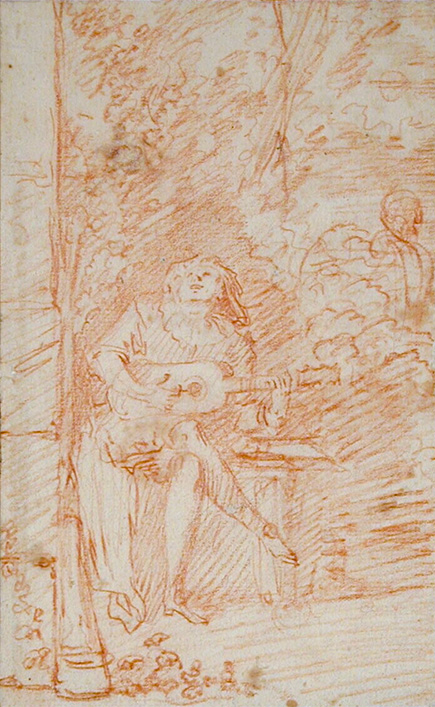
Watteau, Study of a Guitarist Seated in a Garden, red chalk, 16.5 x 10.2 cm. Oxford, Ashmolean Museum.
A second but problematic Watteau drawing associated with Mezetin is in the Ashmolean Museum (Rosenberg and Prat R 488). Despite recent attempts to reattribute the work to Quillard or reject it completely, we believe it is indeed by Watteau. It is visibly earlier in style than the Metropolitan Museum’s canvas but, nonetheless it has all the main features of that painting: a centralized Mezzetin with his head thrown back and his legs crossed, a statue of a classically draped woman seen from behind, and a garden setting. This drawing may have been for an earlier version of the New York painting or may have been an early study that Watteau turned back to when he began the canvas now in New York. Whatever the circumstances, it is futile to deny the closeness between the Oxford drawing and the New York painting.
REMARKS
Writing about Mezetin, most scholars have accepted it as an autograph work. Moreover, they have stressed the impeccable provenance –how it can be traced from the early eighteenth century through to the early twentieth, changing hands only once as it went from Jean de Jullienne, Watteau’s close friend and ally, to Empress Catherine the Great of Russia. This is a prestigious provenance. Disregarding the confusion between height and width, Jullienne's painting was measured as 20 x 17 pouces, that is, 50.8 x 43.2 cm. The extant picture measures 55.3 x 43.1 cm, which is remarkably close in width and only 4.5 cm difference in height.
Nonetheless, there are two notable dissentions. Because of discrepancies between the measurments of the picture described in the Jullienne sale catalogue and the extant painting that came from Russia, Dacier, Vuaflart, and Hérold concluded that the Russian painting must be another version. Moreover, they theorize that the Audran engraving records only the central portion of a larger composition. Similarly, and probably prompted by these men's demurs, Adhémar lists the Jullienne painting as lost. Despite these objections, the Jullienne measurments and those of the Metropolitan Museum's picture essentially do agree.
There are other complicated aspects to the painting’s provenance, however. When the painting was recorded in the manuscript inventory of the Jullienne collection, two serious errors were made. The first is that its measurements were reversed: ”Mezetin jouant de la guitarre par . . . Wateau . . . 23o sur 17o de haut.” But, as we know, its width was not greater than its height. The second mistake concerns the format of the depicted canvas. The small image in the Jullienne inventory shows Watteau’s painting as a horizontal oval. Jullienne had changed the rectangular picture to appear as an oval by reframing it. However, the illuminator drew the picture as though it were a horizontal oval. While it is not unheard of for old inventories to inadvertantly reverse measurements of height and width, it is exceptional when an artist mistakenly or deceitfully depicts the height and width reversed. To fit this oval format, additional landscape was allotted at both sides. One might have theorized that all this pertained to another version of Mezetin, but that is not the case. There is no listing or other record in the Jullienne collection of a horizontal oval Mezetin by Watteau. It is a curious, essentially inexplicable mistake.
The Metropolitan Museum’s Mezetin is one of several Watteau paintings depicting this commedia dell’arte character playing on his guitar. Other examples are the half-length Mezzetin à la guitare in Vaduz, and the Donneur de serenade in Chantilly. Posed similarly, he also figures in La Surprise in the Getty Museum, in Le Rendez-vous, and as a prominent member of the troupe in Les Comédiens italiens in the National Gallery, Washington. In most of these works, the actor serenades someone seemingly nearby but offstage, out of sight. If the musician in the Chantilly Mezzetin seems charged, he is pensive in the New York painting.
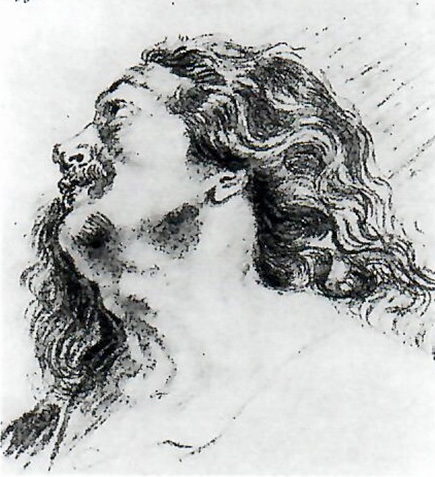
Watteau after Rubens, Head of a Saint, red and black chalk, Oxford, Ashmolean Museum.
With good reason, Mezzetin’s expression—especially his parted lips and rolled-back eyes—has been compared to ecstatic saints by Rubens such as the sheet in the Ashmolean Museum (Rosenberg and Prat 350). Indeed, we should consider the album of drawings by Rubens (actually the work of his studio) that Watteau assiduously copied. But unlike the energetic baroque fervor of Rubens' holy men, here we see a gentler, more poetic expression of emotions. As Edmond and Jules de Goncourt wrote, ”It is Love; but it is poetic Love, the Love that contemplates and dreams, modern Love with its aspirations and its coronal of melancholy." Wintermute (2003) described Watteau's "portrait of Love’s martyr . . . an unsurpassed image of romantic aspiration and torment,“ but there is little martyrdom or torment. Whereas the guitar-playing Mezzetin in Chantilly expresses fervor, here there is contemplative calm.
When the Mezetin was recorded as hanging on the walls of Jullienne’s house, and when it was sold from his collection in 1767, its form was described as oval. This can also be seen in the illustrated manuscript of Jullienne‘s collection. Recent examination of the painting has led to a better understanding of its structure and alterations. It was originally painted on a rectangular canvas. The full palette of colors and rich impasto in the upper left coner attest to its original apearance. The painting in the other three corners show that less attention was paid there. Indeed, it is largely covered by drab-colored paint and a few wisps of foliage.
In modern times, the Metropolitan Museum‘s canvas is presented as an upright rectangle. This was Watteau’s original intention, but he might well have accepted an oval format for Mezetin. A good number of Watteau's paintings were conceived as ovals—a popular shape in the early eighteenth century. This was the format, for example, of Le Rendez-vous.
Much has been written about the identity of the actor. In 1935, when the paining arrived in the museum’s collection, Wehle proposed that it was Luigi Riccoboni, who was famous for playing the role of Mezzetin on stage. Alternate names have been offered such as that of Angelo Constantini. Temperini proposed that it was an allegorical portait of Jullienne himself. However, one by one, these ideas have been rejected by modern scholars, yet no alternative name has gained acceptance.
There is much greater consensus in regard to the date proposed for the paining. When shown in Paris in 1937, it was dated c. 1715-17 but since then it has been assigned a later date, generally around 1717-19. This was the date that Roland Michel chose. Wehle dated the painting 1717-18. Temperini preferred 1717-19. Rosenberg and Prat dated the drawing of the actor’s head to c. 1718, implying a still later date. Posner assigned a date of 1718. Grasselli, as well as Bailey et al., date the canvas c. 1718-1720. Adhémar chose 1719, and latest in this chronology, Mathey assigned it to the years 1717-1721.
For copies of Mezzetin, CLICK HERE
